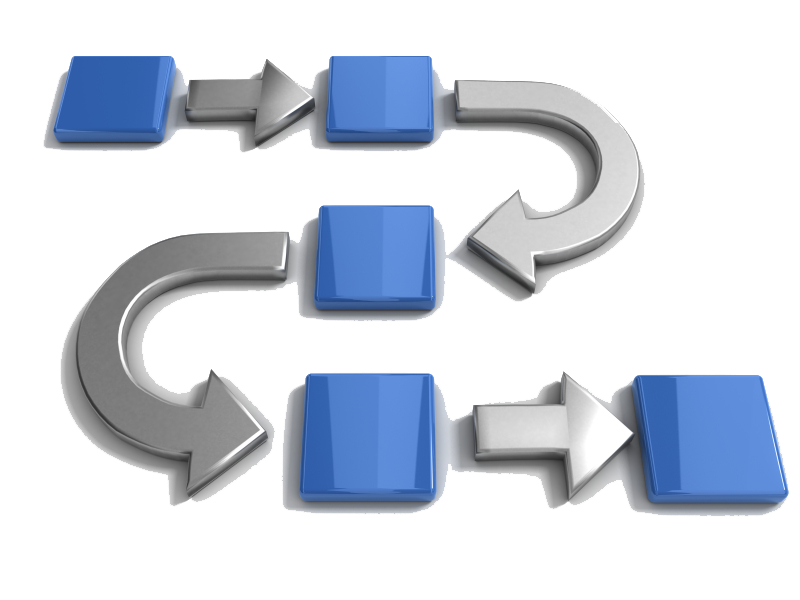Strategy Capabilities
Organizational success begins with a well-defined strategy. Intelligent and highly competent leaders seek outside counsel to expand their thinking and validate their assumptions. Clients turn to Actionable Strategies for our ability to develop strategies based on broad experience across industries, geographies and global challenges. We collaborate with our clients to pragmatically implement the organizational changes required to realize the potential of these strategies.
Applying Lean and Agile approaches enables our clients to transform their organizations while pursuing their strategic objectives. Whether entering new markets, monetizing new products or repositioning in evolving markets, our clients benefit from our success in making strategies actionable. These strategies are durable and consider the evolution of customer, market, technology and regulatory conditions.
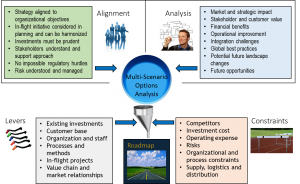 Executives drive organizational success beginning with a well-defined strategy. Intelligent and highly competent leaders seek outside counsel to expand their thinking and validate their assumptions.
Executives drive organizational success beginning with a well-defined strategy. Intelligent and highly competent leaders seek outside counsel to expand their thinking and validate their assumptions.
Actionable Strategies has extensive credentials and practical experience in helping organizations create and execute successful and sustainable strategies. These strategies can be put into action even as market and regulatory conditions evolve.
Utilizing proven frameworks enables our clients to realize results more rapidly with lower costs and reduced risks.
Strategy Formulation: Benefits
Executives drive organizational success beginning with a well-defined strategy. Intelligent and highly competent leaders seek outside counsel to expand their thinking and validate their assumptions.
Actionable Strategies has extensive credentials and practical experience in helping organizations create and execute successful and sustainable strategies. These strategies can be put into action even as market and regulatory conditions evolve.
Engagement Structure
Actionable Strategies uses a proven and structured approach to formulate a strategic roadmap and drive successful execution. The basic process is outlined in the accompanying illustration.
Collaborative Approach
Actionable Strategies collaborates with clients to formulate a strategy that is realizable and not academic. By working with executives and front-line leaders, acceptance and alignment are fostered while objections are unearthed early in the process.
The roadmap consists of a series of deliverables including a target state model. Stakeholders across the organization as well as external parties to the value chain are included in the planning and roadmapping process.
Actionable Strategies’ Value
Actionable Strategies applies proven strategies and techniques so clients can maximize opportunities while minimizing investment, cost and risk. Our consultants have proven experience in strategic planning and development in the U.S. and other global markets.
Relevant past experience includes the following:
- Market entry strategies in high growth industries and in emerging markets
- Growth strategies and profit optimization in mature industries
- Competitive analysis in rapidly changing global industries
- Marketing strategies in complex solutions involving both product and services
- Product strategies differentiating offerings to achieve higher margins and market share
- Sales and distribution channel modeling to ensure sell through and benefits realization against revenue plans
- Strategic business development to achieve initial market penetration
 This global investment bank advises, originates, trades, manages and distributes capital for governments, institutions and individuals. The client offers global electronic trading across cash equities, options, and futures.
This global investment bank advises, originates, trades, manages and distributes capital for governments, institutions and individuals. The client offers global electronic trading across cash equities, options, and futures.
The client is competing with other prominent firms for dramatically lower trading volumes. To compete effectively and win, the client needed to attain a better understanding of key client needs and wants, articulate a roadmap to meet client requirements, and execute against this roadmap.
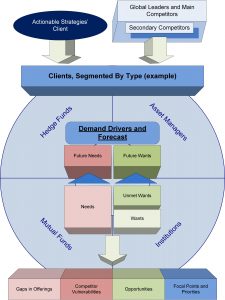 Actionable Strategies used a structured solution framework to assess competitors and target market.
Actionable Strategies used a structured solution framework to assess competitors and target market.
- Segment client base in alignment with strategy
- Determine current and future demand drivers: Basic needs (commoditized) or Wants (differentiators)
- Design and apply competitive analysis to extract vital information
After conducting competitive and market analysis, Actionable Strategies then provided specific product strategy recommendations to re-align product development work. The roadmap presented by Actionable Strategies guided the long-term vision for the product including mobile and tablet platforms. Actionable Strategies was subsequently engaged for further work with the client.
Client Profile
This global investment bank and financial services firm advises, originates, trades, manages and distributes capital for governments, institutions and individuals. The client offers global electronic trading across cash equities, options, and futures. The high touch sales, trading and market-making services are available around the world. Electronic trading tools include a broad suite of algorithms, smart order routing and direct market access.
Business Objective
The client is competing with other prominent firms for trading volumes that are dramatically lower than in previous years. To compete effectively and win vis-à-vis these other firms, the client needed to attain a better understanding of key client needs and wants, articulate a roadmap to meet client requirements, and execute against this roadmap.
Project Overview

Actionable Strategies used a structured solution framework to assess competitors and target market.
- Segment client base in alignment with strategy
- Determine current and future demand drivers
- Basic needs (commoditized)
- Wants (differentiators)
- Design and apply competitive analysis to extract the vital information
- Gap in our ability to meet needs
- Competitors gaps that we can exploit
- Opportunities to provide value add / differentiators
- Most critical areas to emphasize and invest resources
The client engaged Actionable Strategies for a number of reasons.
- Unbiased strategic expertise
- Knowledge of the global markets and participants
- Connections with buy-side clients
- Product and technology knowledge
- Process and financial experience
Project Structure
The project was executed in a number of phases.
Baseline
To drive research design, a market baseline was developed.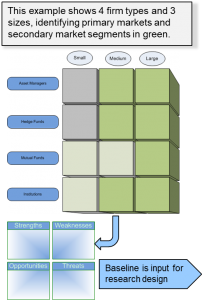
- Clients are first divided into segments with analysis focused on individual segments
- Certain segments will be more important
- Segments may not be targets and should be ignored (e.g., individual investors)
- Strategic focus should be supported by market characteristics (e.g., trading volume relative to AUM)
- Overlay segmentation is also a consideration (e.g., cash, operating region); client-oriented views such as long-only trading strategies vs. long-short should also play a role in understanding client needs and wants
- Internal SWOT analysis forms the baseline for each segment (or group of segments if we decide their behavior is similar)
The sample shows the segmentation approach but is not the exact models used with the client. Segmentation led to a SWOT analysis (strengths, weaknesses, opportunities and threats). In reality, the model was more complex and included overlay segmentation.
Design
The design phase created a plan for focused research. The objective was to provide concrete and actionable competitive intelligence. This enabled us to develop the most effective roadmap to win in the market. The following overall approach was applied to design.
- Consolidate internal and analysts views on the broader market
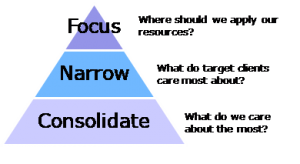
- Provides general trends and direction
- Narrow based on customer and competitors’ clients
- Identify specific needs and opportunities by segment
- Determine comparative competitive landscape
- Use targeted research to prove or disprove hypotheses about reaching clients and taking aware share
- Focus based on specific competitive objectives
- Align to strategy in terms of segment, approach and direction
- Distill to the vital few and prioritize
The following specific approach was used in research design. It was critical to apply multiple hypotheses per goal state as the research also disproved certain hypotheses.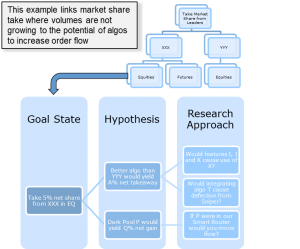
- Based on goal states that align to strategy
- In this example below, take 5% net market share from Competitor S in the Hedge Fund segment for funds between $1B and $5B in AUM
- Create hypotheses that drive actionable plans
- In this example, if we supported a better algo than Sniper, we could convert Y% of the base while sustaining historical losses of Z% leading to A% takeaway
- Generate research approaches that prove or disprove the hypotheses
By developing hypotheses and a focused research approach, meaningful results are attained.
Competitive Research
Actionable Strategies conducted competitive research by directly contacting clients and prospects. The following were the key elements of this approach.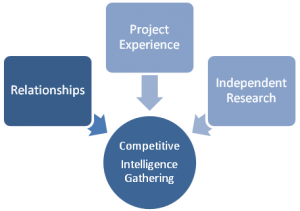
- Identify current and longer term needs and wants
- Negative cases are sought and are highly valuable
- Reasons for rejecting competitors / client
- Constraints in selecting client
- Utilize consulting firm strengths
- Experience from other projects
- Relationships at other institutions
- Ability to conduct independent research
Independent research used the following proven approach.
- Proven bespoke research methods
- Contact clients and prospects to conduct research
- Quid pro quo is anonymous results
- Client receives specific information
- Efficient and ethical
By leveraging the strengths of Actionable Strategies, the client realized tremendous value in a compressed timeframe and efficient cost structure.
The following were sources for research which provided a broad market footprint.
- Draw from first level contacts
- Use second level network to create a larger footprint
- Option of using academic contacts to execute broad based research
- Ability to engage client contacts that client staff might not be able converse with directly
Research Analysis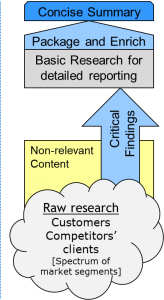
The analysis phase produced the end product for the heads of the business and their executive team.
- Distill raw research into salient findings aligned to hypotheses
- Package into a concise summary
- Crisp encapsulation
- Graphical elements
- Drill downs follow
- Retain basic research for appendices
Key Takeaways
Takeaways from the project need to be non-specific due to the confidential nature of the work. However, the reader can benefit from the value derived by the client.
- Certain hypotheses about client wants were not substantiated by direct conversations – this enabled the client to preserve investment in product development related to requirements that had no value in the market
- Competitive positioning and perceived valued may have differed from reality, but clients and prospects did believe competitive messaging and the opinions of peer institutions – this enabled the client to focus marketing and sales efforts in demonstrating their superior value in those areas
- Segmentation of the market revealed needs specific to given targets – this enabled the client to make informed investment decisions as well as tailor marketing messages by segment
- Product gaps, both real and perceived, were clearly identified – this enabled the client to prioritize product development and enable product support to address perceived gaps
- Executives were highly focused on the executive summary and the detailed information was used for drill-down discussions only; front-line leaders went through all of the detailed research and findings
Business Results
The client used the competitive product strategy recommendations to re-align product development work. The roadmap presented by Actionable Strategies guided the long-term vision for the product including mobile and tablet platforms. Actionable Strategies was engaged for further work with the client.
 The Government of Romania sought to turn Targu Mures into a SmartCity. In Romania, the city has a prominent history. Târgu Mureș is the seat of Mureș County in Transylvania whose history is still acknowledged today.
The Government of Romania sought to turn Targu Mures into a SmartCity. In Romania, the city has a prominent history. Târgu Mureș is the seat of Mureș County in Transylvania whose history is still acknowledged today.
The “Digital Mures” SmartCity strategy had two major objectives:
- Develop a modern infrastructure of private-public services
- Envision and develop a medical IT technology park specializing in research and medical information including telemedicine
The Smart City was expected to generate monetary savings, enhance the lifestyles of citizens and improve the private business environment. Incorporating experience from Telemedicine and Smart Grid projects in Romania, Actionable Strategies concluded that the technologies could support all of the strategic objectives.
Analysis of the structure, capabilities and preparedness of the city, we concluded that a number of constraints needed to be removed prior to implementing the strategic plan. The major issues were human capital, grid interoperability, the regulatory framework, culture, and real estate obstacles including buildings, property rights and energy data. The Government of Romania embraced our strategy and proceeded. By 2019, Romania had 330 Smart City projects covering over 6 million citizens.
Client Profile
 The Government of Romania sought to turn Targu Mures, the capital of Mures County, into a SmartCity. The city is 19 square miles and located in the Mures River Valley, the center of the historical region of Transylvania.
The Government of Romania sought to turn Targu Mures, the capital of Mures County, into a SmartCity. The city is 19 square miles and located in the Mures River Valley, the center of the historical region of Transylvania.
With a population of 142,000, Targu Mures has over 8,500 private and several state-owned companies. There are 3 leading universities with over 10,000 students.
Business Objective
Targu Mures wanted to create the “Digital Mures” SmartCity strategy with two major objectives:
- Develop a modern infrastructure of private-public services
- Envision and develop a medical IT technology park specializing in research and medical information including telemedicine
Smart City Benefits
 The Digital Mures SmartCity strategy is expected to generate monetary savings, enhance the lifestyles of citizens and improve the private business environment. Actionable Strategies has worked with other government entities in Romania on similar digital transformation initiatives.
The Digital Mures SmartCity strategy is expected to generate monetary savings, enhance the lifestyles of citizens and improve the private business environment. Actionable Strategies has worked with other government entities in Romania on similar digital transformation initiatives.
 Telemedicine Objectives
Telemedicine Objectives
An objective of the strategy is to create the “Scientific City for Medical IT” to contribute to the development of telemedicine and the IT industry. Thousands of employment opportunities will be created in Targu Mures. Actionable Strategies has successfully completed a telemedicine project in Romania which proved the economic and technical viability of the model in Romania.
Smart Grid Technologies
 From a technology perspective, Actionable Strategies was engaged to assess the viability of powering the SmartCity via SmartGrid technology deployment. Our experience with SmartGrids in Romania and emerging markets was applied throughout the project.
From a technology perspective, Actionable Strategies was engaged to assess the viability of powering the SmartCity via SmartGrid technology deployment. Our experience with SmartGrids in Romania and emerging markets was applied throughout the project.
The Government of Romania sought to create a model for a Smart City which it could replicate across Romania, and throughout South Eastern Europe.
Strategic Analysis
 The strategic study considered strategy, management, technology, human capital, regulatory, cost and risk aspects of the SmartCity objectives. The major focus was on establishing a Micro Grid to deliver the power required for a Smart City.
The strategic study considered strategy, management, technology, human capital, regulatory, cost and risk aspects of the SmartCity objectives. The major focus was on establishing a Micro Grid to deliver the power required for a Smart City.
The energy strategy addressed the high cost and inefficient use of electrical and heating energy, both identified as major problems of the city. The city spends a significant amount of its budget on energy while relying on a limited number of energy suppliers, creating risk and cost issues.
Targu Mures planned for the development of an integrated system of energy production and use. Renewable resources were a major part of energy mix. Non-traditional power generation schemes included:
- Biogas
- Geothermal
- Cogeneration
Smart Grid Technologies
Powering the SmartCity considered many advanced technologies. These modern technologies were targeted for energy savings, enhanced energy efficiency and reduced greenhouse gases.
Generation
Clean generation and resilience were key technology choices.
- Distributed Generation
- Photovoltaic Solar systems
- Waste-to-energy generation
Infrastructure
Infrastructure investments were required to enable end-to-end grid management and operation.
- Advanced Telecommunications Platform
- Supervisory and Management technologies
Distribution
Advanced distribution was planned to maximize efficiency and minimize service disruptions.
- Energy Distribution Management
- Smart Metering
- Asset Management
Consumption
Technology was planned for the endpoints to optimize grid operations and maximize energy savings.
- Energy Efficient Buildings
- Public lighting technologies
Key Findings
Smart City technologies were found to be mature enough to support the digital agenda of Targu Mures. Other key constraints were identified that needed to be addressed to succeed in implementing the Smart City strategy.
Human Capital Shortage
 Implementation and operation of Micros Grid technologies necessitated improved Human Capital capabilities. This required over 12 months of lead time for extensive hiring and intensive training and hiring.
Implementation and operation of Micros Grid technologies necessitated improved Human Capital capabilities. This required over 12 months of lead time for extensive hiring and intensive training and hiring.
- Management – Experienced program and project managers are required for implementation and skilled managers will then need to run operations
- Skilled resources – Deployment and operations of the Micro Grid and Smart City technologies require a significant number of skilled engineering and scientific resources, which are not currently available in Targu Mures.
Grid Interoperability
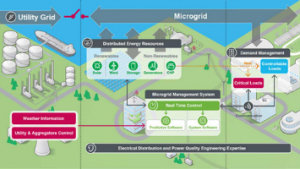 The incumbent power distribution company was not prepared to connect a Micro Grid to the distribution network. In addition to issues with operating over existing wiring, a number of operational issues had to be resolved.
The incumbent power distribution company was not prepared to connect a Micro Grid to the distribution network. In addition to issues with operating over existing wiring, a number of operational issues had to be resolved.
- Negotiation of the interconnect agreement
- Agreement on protection settings for bi-directional energy flow
- Net Metering for bi-directional energy flow payments and other compensation
- Time of Use pricing
Regulatory Framework
 The Romanian Energy Regulatory Authority had not defined the framework for Micro Grids and interconnection to the distribution network. Based on Actionable Strategies experience in other projects in Romania, significant delays were anticipated.
The Romanian Energy Regulatory Authority had not defined the framework for Micro Grids and interconnection to the distribution network. Based on Actionable Strategies experience in other projects in Romania, significant delays were anticipated.
Real Estate
 Municipal buildings are old, not thermally insulated, fitted with old windows, and register very large energy losses. Significant effort outside the scope of a Micro Grid would be required to make these buildings energy efficient.
Municipal buildings are old, not thermally insulated, fitted with old windows, and register very large energy losses. Significant effort outside the scope of a Micro Grid would be required to make these buildings energy efficient.
Electrical wiring, panels, heatsinks and other electrical equipment are also old and would require upgrades to attain energy savings projected from the Micro Grid.
Energy audits had not been performed to develop a phased plan to upgrade buildings based on impact and implementation cost.
Culture and Communication
 The plan lacked a strategy to address cultural issues related to energy-saving. Repeated communication over time to change behaviors that led to wasteful energy practices was not built into the plan.
The plan lacked a strategy to address cultural issues related to energy-saving. Repeated communication over time to change behaviors that led to wasteful energy practices was not built into the plan.
 In Romania, there is no culture of energy saving. For example, interior lights are turned on everywhere throughout the day when it is not necessary. Excessive temperature in rooms is addressed by opening windows.
In Romania, there is no culture of energy saving. For example, interior lights are turned on everywhere throughout the day when it is not necessary. Excessive temperature in rooms is addressed by opening windows.
 This culture is found at a larger level. Buildings do not provide the ability for tenants to control indoor temperatures, leading to tremendous waste. Sub-metering is not available leading tenants to be indifferent to energy savings. At the municipal level, individual building do not have metering leading to complete disregard for energy consumption.
This culture is found at a larger level. Buildings do not provide the ability for tenants to control indoor temperatures, leading to tremendous waste. Sub-metering is not available leading tenants to be indifferent to energy savings. At the municipal level, individual building do not have metering leading to complete disregard for energy consumption.
Recommendation
 Actionable Strategies recommended that the Government of Romania halt the impending start of the initiative until further analysis and planning was conducted. In addition, further risk management in planning was required. While disappointing, this advice was in the best interests of the client and the detailed analysis and honest assessment were appreciated.
Actionable Strategies recommended that the Government of Romania halt the impending start of the initiative until further analysis and planning was conducted. In addition, further risk management in planning was required. While disappointing, this advice was in the best interests of the client and the detailed analysis and honest assessment were appreciated.
Business Results
 The Government of Romania was better enabled to successfully embark on Smart City Strategies, including Targu Mures. Smart City initiatives have subsequently spread across Romania. By 2019, Romania had 330 Smart City projects covering over 6 million citizens.
The Government of Romania was better enabled to successfully embark on Smart City Strategies, including Targu Mures. Smart City initiatives have subsequently spread across Romania. By 2019, Romania had 330 Smart City projects covering over 6 million citizens.
 Actionable Strategies created the strategy and technology roadmap for the Central Power Corporation of Vietnam. Rapid economic growth placed pressure on the power grid for all sectors of the economy. The adoption of free market reforms demanded a modern market structure with organizations able to make the transition to a market economy. The Central Power Corporation required a strategy and extended roadmap to enable it to operate effectively in a competitive structure.
Actionable Strategies created the strategy and technology roadmap for the Central Power Corporation of Vietnam. Rapid economic growth placed pressure on the power grid for all sectors of the economy. The adoption of free market reforms demanded a modern market structure with organizations able to make the transition to a market economy. The Central Power Corporation required a strategy and extended roadmap to enable it to operate effectively in a competitive structure.
The project had ambitious goals to make the utility world class across all facets of the company. Specific business goals were defined and assigned underlying target metrics.
- Reduce system losses
- Improve management
- Improve operational efficiency
- Improve the quality of supply and electricity services to customers
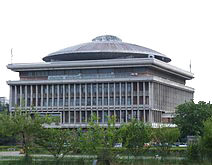 Actionable Strategies evaluated the potential for a variety of Smart City technologies for the campus of the University Politehnica of Bucharest, the largest and oldest technical university in Romania. The technical, financial, regulatory and environmental feasibility were assessed.
Actionable Strategies evaluated the potential for a variety of Smart City technologies for the campus of the University Politehnica of Bucharest, the largest and oldest technical university in Romania. The technical, financial, regulatory and environmental feasibility were assessed.
The study ultimately led to funding for the Smart Campus initiative.
- Smart Grid and Microgrids
- Smart Lighting
- Solar Power
- Electric Vehicles
- Smart Buildings
- Smart Transportation
The Smart Grid included Distributed Energy Resources and energy storage.
 Actionable Strategies created the strategy for a Smart Grid in Myanmar. Initially focused in the capital, Yangon, a roadmap was developed which progressed from grid modernization to support for Smart Cities in Myanmar. The Smart Grid roadmap led to a proposal for project financing requiring approval from diverse stakeholders including state owned transmission and distribution companies. Ultimately, the Ministry of Electricity and Energy approved the strategic plan that included quantified benefits, risks, and financial projections.
Actionable Strategies created the strategy for a Smart Grid in Myanmar. Initially focused in the capital, Yangon, a roadmap was developed which progressed from grid modernization to support for Smart Cities in Myanmar. The Smart Grid roadmap led to a proposal for project financing requiring approval from diverse stakeholders including state owned transmission and distribution companies. Ultimately, the Ministry of Electricity and Energy approved the strategic plan that included quantified benefits, risks, and financial projections.
Initial implementation in 10 townships of $200 million was secured. Additional debt financing of $500 million was arranged for subsequent expansion. Unfortunately, the Coup d’État occurred two days before the Minister could formally sign the required approval and bankable concession agreement.
Actionable Strategies articulated benefits across several dimensions: Economic, Social, Environmental, Critical Infrastructure and Human Capacity. These aligned with UN Sustainable Development Goals and Myanmar’s Sustainable Development Plan. The project supported Myanmar’s commitment to the UN Paris Climate Accord.
 Actionable Strategies created the strategy and technology roadmap for the largest Smart Grid implementation in Turkey. Building on our technical assistance with distribution automation and AMI, the advanced Smart Grid integrated Microgrids, Distributed Generation, and Electric Vehicles. The strategy, architecture and technical approaches served as the model for other Smart Grids in the region. Technical challenges included integration of SAP IS/U via Enterprise Service Bus, deployment of a hybrid communications network, ingestion and analytics of real-time operational data, consolidated customer master data and cybersecurity.
Actionable Strategies created the strategy and technology roadmap for the largest Smart Grid implementation in Turkey. Building on our technical assistance with distribution automation and AMI, the advanced Smart Grid integrated Microgrids, Distributed Generation, and Electric Vehicles. The strategy, architecture and technical approaches served as the model for other Smart Grids in the region. Technical challenges included integration of SAP IS/U via Enterprise Service Bus, deployment of a hybrid communications network, ingestion and analytics of real-time operational data, consolidated customer master data and cybersecurity.
 World-class organizations use repeatable and effective strategic planning processes to drive future success. However, even the best companies encounter dramatic change during the course of the year which causes execution to drift away from strategic goals.
World-class organizations use repeatable and effective strategic planning processes to drive future success. However, even the best companies encounter dramatic change during the course of the year which causes execution to drift away from strategic goals.
Working with clients to realign strategies, Actionable Strategies applies a framework for rapid strategic planning outside of the normal cycle.
In-flight Drivers
World-class organizations use repeatable and effective strategic planning processes to drive future success. However, even the best companies encounter dramatic change during the course of the year which causes execution to drift away from strategic goals. Examples of such changes include:
 Mergers and acquisitions
Mergers and acquisitions- Reorganizations
- Market-driven initiatives requiring focus
- Tactical emergencies diverting resources
- Initiative re-prioritization
- Missed program or project milestones
- Changes in leadership
Re-alignment
Re-alignment involves evaluation of current and planned activities against strategic drivers. Often activities can fit into larger business objectives but require re-definition. Once re-defined, clear communication and linkage of plans can ensure that groups and individuals have a coherent sense of their fit into overall organizational objectives.
Approach and Deliverables
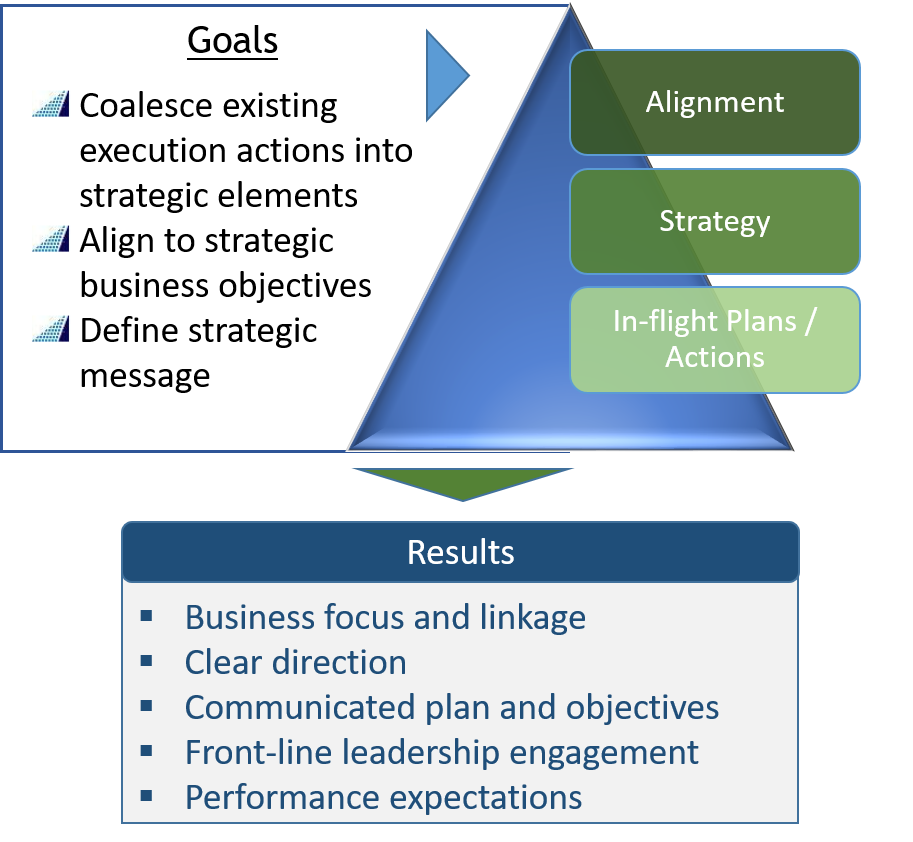 Rather than following a prescriptive approach, Actionable Strategies leverages in-flight efforts and executes collaboratively. The following techniques are used to establish and maintain momentum and buy-in at all levels of the organization.
Rather than following a prescriptive approach, Actionable Strategies leverages in-flight efforts and executes collaboratively. The following techniques are used to establish and maintain momentum and buy-in at all levels of the organization.
- Workshops with front-line leaders
- Interviews with staff and leadership
- Collaborative strategy sessions
- Planning and budgeting exercises
These activities yield the following deliverables.
- Categorized initiatives mapped to stakeholders
- Pragmatic project portfolio with stratified approaches including lights-on/BAU
- Strategy aligned to business objectives
- Communication materials
Enablement
Completion of In-flight Strategic Alignment will enable business management capabilities such as:
- Metrics-based reporting and tracking
- Dashboards and predictive modeling
- Performance based compensation
- Future incremental strategic planning
Engagement Structure
Actionable Strategies will define a pragmatic approach for each client. A sample end-to-end engagement roadmap is depicted below.

 The client provides financing for green real estate projects. Investments are made in both new development as well as retrofitting projects that reduce energy costs and carbon footprints. Projects include energy efficiency, co-generation, renewables, fuel conversions and demand response.
The client provides financing for green real estate projects. Investments are made in both new development as well as retrofitting projects that reduce energy costs and carbon footprints. Projects include energy efficiency, co-generation, renewables, fuel conversions and demand response.
 The business outsourced IT but did not believe it was being well-managed. The value received vs. the rate of spend was questioned by senior leadership. Actionable Strategies was recommended by another real estate client as an unbiased expert in evaluating IT Strategy and providing actionable recommendations.
The business outsourced IT but did not believe it was being well-managed. The value received vs. the rate of spend was questioned by senior leadership. Actionable Strategies was recommended by another real estate client as an unbiased expert in evaluating IT Strategy and providing actionable recommendations.
Actionable Strategies delivered an IT Strategy that aligned to business strategy and the specific needs of leaders and stakeholders. The project was highly successful and Actionable Strategies was retained to select vendors and drive implementation of the strategy.
Client Profile
The client provides funding for green real estate projects. Investments are made in both new development as well as retrofitting projects that reduce energy costs and carbon footprints. Projects include energy efficiency, cogeneration, renewables, fuel conversions and demand response. The firm invests in projects across all building types in the boroughs of New York City.
Business Challenge
The business outsourced the IT function but did not believe it was being well-managed. The value received compared to the rate of spend was also questioned by senior leadership. Actionable Strategies was recommended by another client as an unbiased expert in evaluating IT Strategy and providing actionable recommendations.
Solution Approach
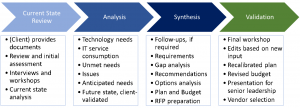 Actionable Strategies applied the following basic methodology used successfully with many clients.
Actionable Strategies applied the following basic methodology used successfully with many clients.
This client retained sensitive financial data making IT risk management a key consideration. Software development was not a factor since the firm only used packaged applications managed by external vendors. Analysis focused on unmet needs and unfulfilled requirements of the business. Previously, technical considerations drove decision making.
Strategic Considerations
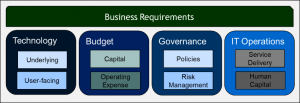 Strategic planning activities covered the management spectrum:
Strategic planning activities covered the management spectrum:
- Alignment: Ensuring that the IT Strategic Plan mapped directly to business strategy through direct input from stakeholders
- Governance: Management, supervision and reporting processes required to manage IT
- Finance: Budgetary benchmarking, forecasting, and cost control measures
- Operations: Establishing and maintaining levels of service to the business
Notable Results
 Actionable Strategies delivered an IT Strategy that aligned to business strategy and the specific needs of leaders and stakeholders.
Actionable Strategies delivered an IT Strategy that aligned to business strategy and the specific needs of leaders and stakeholders.
The client subsequently engaged Actionable Strategies to select vendors and drive implementation of the strategy. Key results, verified over the following years, included:
- Management – Improvement in IT management was introduced including direct stakeholder engagement, planning and budgeting against the IT Strategic Plan and Roadmap
- Capabilities – In addition to an improvement in basic IT services, data analytics became a defined and funded initiative.
- Efficiency – Process improvement and a restructured service delivery model dramatically increased service levels, including 24×7 support, while costs remained comparable to other benchmarked organizations
- Mobile Computing – Users gained the ability to remain productive outside of the office where many key contributors worked, resulting in significant gains for the business
- Customer Satisfaction – End users received dramatically better service and the number of issues dropped significantly
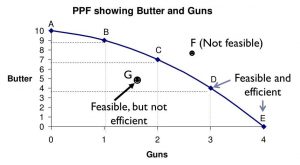 Motivated to expand quickly, firms in growth industries are faced with a number of challenges as well as opportunities. The challenges are amplified for firms in emerging markets but the commensurate rewards are greater. This paper discusses one element that is fundamental to success: core strategy during initial ramp up. The driver for strategic focus is the economic principle of the production possibility frontier.
Motivated to expand quickly, firms in growth industries are faced with a number of challenges as well as opportunities. The challenges are amplified for firms in emerging markets but the commensurate rewards are greater. This paper discusses one element that is fundamental to success: core strategy during initial ramp up. The driver for strategic focus is the economic principle of the production possibility frontier.

